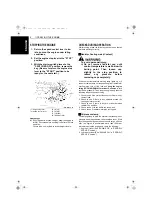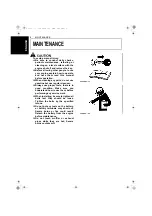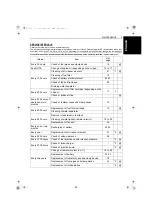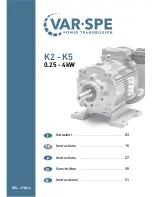
SAFE OPERATION
2
EN
GLISH
3. CHECK BEFORE STARTING & OPERATING THE ENGINE
A
Be sure to inspect the engine before operation. Do not
operate the engine if there is something wrong with it.
Repair it immediately.
A
Ensure all guards and shields are in place before
operating the engine. Replace any that are damaged or
missing.
A
Check to see that you and others are a safe distance
from the engine before starting.
A
Always keep the engine at least 3 feet (1 meter) away
from buildings and other facilities.
A
DO NOT allow children or livestock to approach the
machine while the engine is running.
A
DO NOT start the engine by shorting across starter
terminals. The machine may start in gear and move. Do
not bypass or defeat any safety devices.
4. KEEP THE ENGINE AND SURROUNDINGS CLEAN
A
Be sure to stop the engine before cleaning.
A
Keep the engine clean and free of accumulated dirt,
grease and trash to avoid a fire. Store flammable fluids in
proper containers and cabinets away from sparks and
heat.
A
Check for and repair leaks immediately.
A
DO NOT stop the engine without idling; Allow the engine
to cool down, first. Keep the engine idling for about 5
minutes before stopping unless there is a safety problem
that requires immediate shut down.
5. SAFE HANDLING OF FUEL AND LUBRICANTS -KEEP AWAY FROM FIRE
A
Always stop the engine before refueling and/or
lubricating.
A
DO NOT smoke or allow flames or sparks in your work
area. Fuel is extremely flammable and explosive under
certain conditions.
A
Refuel at a well ventilated and open place. When fuel
and/or lubricants are spilled, refuel after letting the
engine cool down.
A
DO NOT mix gasoline or alcohol with diesel fuel. The
mixture can cause a fire or severe engine damage.
A
Do not use unapproved containers e.g. buckets, bottles,
jars. Use approved fuel storage containers and
dispensers.
E.book 2 ページ 2009年4月23日 木曜日 午前10時31分







































